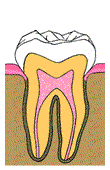The endodontic
services we offer include the following:
 Consultation
and Diagnosis Consultation
and Diagnosis
Your dentist has referred you to our office for an endodontic evaluation and
possible treatment.
Non-surgical
Root Canal Therapy
Root canal therapy involves the cleaning, shaping and filling of the canal
space within the root of the tooth.
Non-surgical
Root Canal Retreatment
Retreatment is necessary when the root canal becomes reinfected. It is usually
possible to perform the root canal treatment again and create an environment
which will promote healing.
Surgical
Endodontics
When retreatment is not possible or is not successful, a surgical approach
can be used.
Differential
Diagnosis of Oral Facial Pain
Endodontists are trained to differentiate between pain of endodontic origin
and non-dental pain.
Internal
Bleaching or Nonvital Bleaching
This procedure is used to lighten a darkly discolored tooth that has had a
root canal.
Additional services:
- DVD movie glasses
- Wheelchair accessibility
For your safety our
office features:
- Our office meets or
exceeds all OSHA standards of sterilization and infection control
- Disposable covers and
medical supplies
- Protective clothing:
masks, gloves, gowns, goggles
- State of the art sterilization
techniques and monitoring
- Continuing education
for staff in infection control and CPR training
Consultation
and Diagnosis
Your dentist has referred
you to our office for an endodontic evaluation and possible treatment. We
will review your medical and dental history, chief complaint, perform diagnostic
tests, and study all x-rays. It is sometimes necessary to have additional
x-rays taken in order to provide a three dimensional view of the tooth in
question.
The goals of an endodontic
evaluation are:
- Determine if you are
in need of endodontic (root canal) treatment
- Identify the source
of the pain.
Patients often experience
generalized pain and are unable to identify the problem tooth. Sometimes pain
can be felt in an area that is different from the one in which it originates.
When the source of pain is different from the site of pain, this is commonly
known as referred pain.
Surgical
Endodontics
Sometimes a non-surgical
approach for root canal therapy is not possible. Skillful diagnosis in endodontic
surgery requires accurate determination of the reasons for endodontic failure.
Most common causes for failure are: unusual, complex and undetectable root
canal anatomy, accessory canals that cannot be treated conventionally, or
a fractured root. Other factors which may require a surgical approach, include
the presence of a post which cannot be removed, calcification of the canals,
or obstruction due to a separated instrument. Most of these cases can be successfully
treated with endodontic surgery.
The goal
of all endodontic surgery is to remove disease, prevent it from recurring,
and to create an environment in which healing may occur.
The surgical procedure
itself is done in the dental office, under local anesthetic. It can take approximately
two or three hours, and most patients return to work after the procedure.
Some of the most common endodontic surgeries are:
Apicoectomy
(or Root-End Resection)
Hemisection
Root Amputation
|







